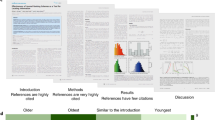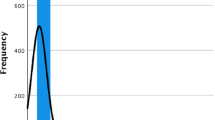Abstract
The paper examines the role played by the scientific journal in the citation process. It compares characteristics of journals which publish the articles cited and those which cite them. It pays attention to the regional location, degrees of specialization, and visibility of journals and investigates how these factors relate to accumulation of citations. The data consist of a subsample of Nordic cardiovascular research articles, published in 1981, and of the articles citing them until early 1988.
Similar content being viewed by others
Notes and references
S. Cole, J.R. Cole, Testing the Ortega Hypothesis: Milestone or millstone?Scientometrics, 12 (1987) 345–353.
R.K. Merton, The Matthew Effect in science,Science, 159 (1968) 56–63.
R.K. Merton,op. cit., ref. 2.
S. Cole, J.R. Cole,op. cit., ref. 1.
J.R. Ravetz,Scientific Knowledge and its Social Problems, Oxford; Claredon Press, 1971, 282.
F. Narin, G. Pinski, H.H. Gee, Structure of the biomedical literature,Journal of the American Society for Information Science, 27 (1976) 25–45.
T. Luukkonen, Publish in a visible journal or perish? Assessing citation performance of Nordic cancer research,Scientometrics, 15 (1989) 349–367.
F. Narin, An Assessment of the Factors Affecting Critical Cancer Research Findings. Final report submitted to the National Cancer Institute, National Institutes of Health, September 30, 1987.
An example of such studies might be that byS.J. Ceci, D.P. Peters, Peer review: A study of reliability,Change, (1982) 44–48.
J.D. Frame, F. Narin, The national self-preoccupation of American scientists: An empirical view,Research Policy, 17 (1988) 203–212.
See alsoL. Velho, The “meaning” of citation in the context of a scientifically peripheral country,Scientometrics, 9 (1986) 71–89.
L. Velho, The author and beholder: How paradigm commitments can influence the interpretation of research results,Scientometrics, 11 (1987) 59–70.
T Luukkonen, Citation indicators and peer review: Their time-scales, criteria of evaluation, and biases,Research Evaluation, (1990) forthcoming.
M.J. Moravcsik, In the beholder's eye: A possible reinterpretation of Velho's results on Brazilian agricultural research,Scientometrics, 11 (1987) 53–57. I am also grateful to my colleague,Teuvo Räty, for pointing this out to me.
J.D. Frame, F. Narin,op. cit.. ref. 14.
If we want to include that part of the national publication activity which is not covered by international databases, we will have to include the citations given in this literature in our analysis, too. This was not done byVelho,op. cit. ref. 16, in her reply toMoravcsik,op. cit. ref 18. In the beholder's eye: A possible reinterpretation of Velho's results on Brazilian agricultural research,Scientometrics, 11 (1987) 53‐57. I am also grateful to my colleague,Teuvo Räty, for pointing this out to me.
T. Luukkonen,op. cit., ref 7.
M.D. Gordon, How authors select journals: A test of the reward maximization model of submission behaviour,Social Studies of Science, 14 (1984) 27–43.
SeeT. Luukkonen,op. cit., ref. 7.
T. Luukkonen,op. cit., ref. 7.
R. Whitley, Types of science, organizational strategies and patterns of work in research laboratories in different scientific fields,Social Science Information, 17 (1978) 427–447. The term ‘configurational’ sciences was first suggested byN. Elias in his article: The sciences: Towards a theory. In:R. Whitley (Ed.),Social Processes of Scientific Development, London; Routledge and Kegan Paul, 1974. The term refers to the ordering of sciences in terms of the degree of integration of their objects, theories, and methods.
H. Zuckermann, R.K. Merton, Age, aging, and age structure in science. In:M.W. Riley, M. Johnson, A. Foner (Eds),A Sociology of Age Stratification, Vol. 3,Aging and Society, New York; Russel Sage Foundation, 1972.
SeeT. Luukkonen,op. cit. ref. 7.
O. Järvinen, H. Pietiäinen, Citation patterns of papers published in Ornis Fennica,Ornis Fennica, 65 (1988) 31–36.
E. Garfield, The articles most cited in 1961–1982. 4. 100 additional citation Classics,Current Contents, No. 40, October 1, 1984, 306–312.
J.R. Ravetz,op. cit. ref. 5.
Author information
Authors and Affiliations
Rights and permissions
About this article
Cite this article
Luukkonen, T. Publication structures and accumulative advantages. Scientometrics 19, 167–184 (1990). https://doi.org/10.1007/BF02095345
Received:
Issue Date:
DOI: https://doi.org/10.1007/BF02095345




